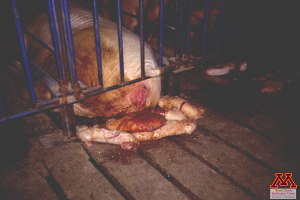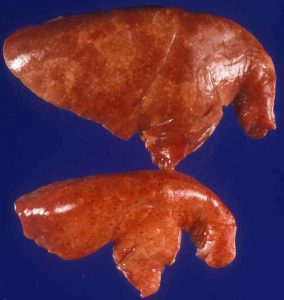Major Infectious Diseases
Porcine Reproductive and Respiratory Syndrome
Clinical importance
Porcine Reproductive and Respiratory Syndrome (PRRS) is the most economically important disease in swine production today, costing around 664 million of dollars per year in profit loss in the US. It is an ubiquitous viral disease and present worldwide. All ages can be affected from young piglets to growing pigs to sows. PRRS control is challenging; entire production systems have been centered around attempting to eliminate the disease.
Etiology and transmission
The PRRS virus is enveloped, made of RNA, and part of the family Arteriviridae, which is closely related to Coronaviridae and Roniviridae. There are two major genotypes: type 1 and type 2. While both types are found around the globe, type 1 is more prevalent in Europe and Russia, whereas type 2 dominates in North America and South-East Asia. A few countries are still indemn from PRRS, Brazil being the one with major swine production. Within each genotype, there are vast genetic differences between strains, making them more or less virulent. This contributes to the difficulty in controlling PRRS. Several modes of transmission are possible. It can happen in utero as the virus can cross the placenta, or during the first weeks of life during which the piglets can be infected by the sow. Boars can shed the virus in their semen, transmitting the virus through mating. Pigs can contaminate each other by nose-to-nose contact, so carrier pigs are a transmission risk. PRRS has been shown to persist in swine for up to 200 days post infection and pigs can easily pass the virus to newly introduced animals who are susceptible. Indirect transmission via fomites is common, through contaminated boots, trucks, coveralls etc or through equipment such as needles and scalpel blades used at processing. Lastly, the spread of PRRS via aerosol is an additional risk. Luckily, PRRS is a pretty fragile virus since it is enveloped and it can be inactivated by heat and desiccation.
Once a pig has come in contact with an infectious dose, the virus replicates in lymphoid tissues and more specifically targets the pulmonary alveolar macrophages or PAMs.
Which transmission route is NOT associated with PRRS spread?
- Nose-to-nose
- In utero
- Feco-oral
- Through fomites
Associated symptoms
At the sow farm

PRRS usually crosses the placenta of sows during their last-third of gestation, causing abortions after 100 days of gestation. Fever and anorexia are common and sometimes even sow mortality if the PRRS virus strain is extremely virulent. The number of mummies and stillborn piglets per litter increases dramatically. Piglets born alive are weak, leading to high pre-weaning mortality rates (60%). Suckling piglets are gaunt with a coarse haircoat. They seem apathetic and can show signs of dyspnea also called “thumping.”
Reproductive issues in a herd may last for up to three months, but if naïve gilts continue to be introduced to the herd, the problems may last longer. Those clinical signs, typical of an epidemic infection, tend to disappear after 2 to 4 months, time at which the situation becomes endemic. In endemic farms, gilts are the most susceptible to the virus and may express some of the clinical signs listed above.
At the nursery and/or growing-finishing site
Nursery and growing pigs typically show respiratory symptoms. Symptoms occur when the maternal immunity fades off and does not protect them anymore. Anorexia, dyspnea, rough hair coats, and a general failure to thrive are the most common clinical signs. A typical herd affected with PRRS has pigs of uneven size, as it causes widely variable daily weight gain. Interestingly, coughing is rare. PRRS is septicemic and was originally called the “blue-ear disease” due to the cyanosis of the extremities that can happen with the most virulent strains. Pigs that are affected by PRRS are also more susceptible to secondary infections as PRRS virus targets the macrophages in the alveoli.
Just like influenza, PRRS induces coughing in growing pigs. True or False?
- True
- False
Associated lesions
Macroscopic lesions

Macroscopic lesions are typically seen in the lungs and the lymph nodes. Lungs show signs of interstitial pneumonia and therefore, look moist and feel firm under the touch. They can be discolored, and are described as mottled or tan. Most lymph nodes are enlarged and often tan in color.
Microscopic lesions
Necrotic debris of macrophages and fluid can be found in the alveoli. Cuffing of lymphocytes can be seen around the airways and the blood vessels of the lungs. In the lymph nodes, lymphoid depletion and necrosis of the germinal center is the most likely lesion.
What is the best description of a lung infected with PRRS?
- Mottled, tan, firm and moist
- Red-purple cranioventral consolidation
- Necrotic, fibrino-hemorrhagic
Diagnosis
Clinical signs and typical lesions are not enough to definitively diagnose PRRS virus in a herd. Depending on the types of herd being investigated, the type of samples taken is different. In cases of abortion, submitting the aborted fetuses with serum samples of the affected sow as well as serum samples from 10 sows of her group is recommended. Serum samples from weak-looking piglets are also a good testing option. Those samples are then tested via PCR. In respiratory cases, numerous sample types can be submitted, oral fluids, nasal swabs, serum samples or lung and lymph nodes tissues can all be used to detect the virus via PCR as well.
Once the virus has been detected, it is common for veterinarians to require sequencing of the ORF5 gene (the most variable) to establish of the strain is a new introduction or not. Whole genome sequencing can also be performed. Virus isolation can be used to grow the virus for the creation of autogenous vaccines.
If the goal of the testing is to establish herd status, group samples are preferable to test by PCR. In this case, oral fluids are efficient in growing pigs whereas processing fluids seem promising in sow farms. Serology on serum or oral fluids is effective but the interpretation is challenging if the pigs have been vaccinated.
Differential Diagnosis
PRRS differential diagnosis should include leptospirosis, parvovirus (reproductive symptoms) and pseudorabies, swine influenza and PCV2 (both respiratory and reproductive symptoms).
What type of samples and diagnostic test would you use to assess the herd status of a growing herd?
- Serology on serum samples
- PCR on oral fluids
- Virus isolation on nasal swabs
Treatment, Prevention and Control
There is no specific PRRS treatment, so preventing, controlling, and possibly eradicating the disease are the best methods for dealing with PRRS.
Suckling piglets are the population shedding the highest amount of virus on the sow farm so during a PRRS outbreak, so cross-fostering (i.e. the adoption of piglets by a new sow) should be avoided. Farrowing rooms should be run in an all-in, all-out management so that piglets in one room are all approximately the same age.
Vaccination of the entire herd and of the weaned piglets in endemic cases or in high density area is the best way to avoid clinical signs by increasing herd immunity. Commercial modified-live vaccines are most commonly used. However, PRRS virus mutates easily and represents a moving target with new strains developing. Sometimes cross-protection is not enough to protect the sows from a new introduction and autogenous immunization may be implemented.
In any case, it is important to acclimate the gilts to the herd. Gilts should be vaccinated or exposed to the farm strains so that they develop immunity before their introduction into the herd.
The virus is not very resistant in the environment so thorough cleaning and disinfection of the barns/rooms should prevent the spread of PRRS from one group to the next
PRRS elimination can be done several ways. The most drastic one is to depopulate the herd and repopulate it with naïve animals. This solution is very effective but stops the production of piglets for several weeks, making it very expensive for the producer.
The most popular option for PRRS elimination is called the Load-Close-Expose protocol or herd closure. In a nutshell, gilts are brought into the herd; the herd is closed, meaning that no animal comes in or comes out beyond the weaned piglets; and the entire herd is exposed to the virus, usually by inoculation or vaccination. The goal is to build the immunity of the herd by burning out the virus. If there is no animal susceptible to PRRS, the virus eventually disappears from the environment. The herd opens back up when the piglets are systematically negative at weaning for at least 3 months. At that time, new naïve gilts need to be introduced to the herd and they should remain negative for PRRS.

